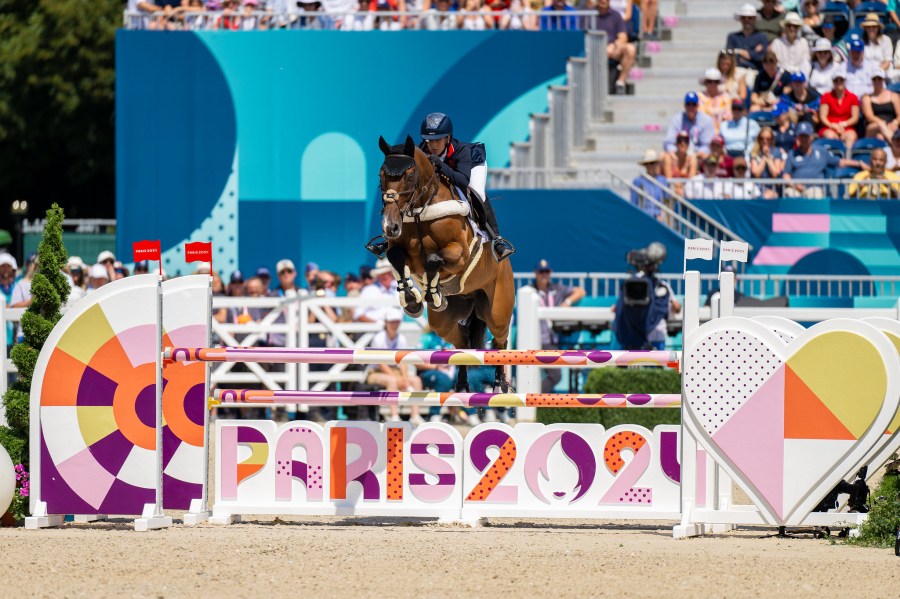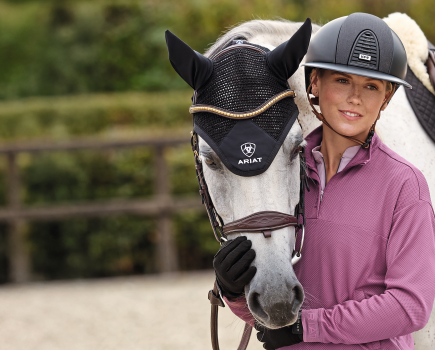There are three equestrian sports in the Olympics: eventing, dressage and jumping. Within each there are team medals and individual medals to win.
Here we explain exactly what these three sports are, as well as modern pentathlon — which includes an equestrian element for the final time at the 2024 Paris Olympic Games — and an overview of the history of equestrian at the Olympics.
History of equestrian sport at the Olympics
Equestrian sport made its debut in the Olympics of Ancient Greece way back in 680 BC, when chariot racing was one of the main events.
It wasn’t until the 1900 Games in Paris that equestrian sport featured in the Olympics programme as we know it today. Equestrian wasn’t included in the next two Olympics, but returned in 1912.
Since then, equestrian sport has always been on the programme.
Until 1948, only male riders could compete in the equestrian Olympics and these riders had to be officers.
This restriction was lifted in 1951 and women started competing in dressage at the Olympics held in Helsinki in 1952.
Women were able to take part in all equestrian events at the Olympics in 1964.
Equestrian remains the only sport in which men and women compete against each other.
What is jumping?
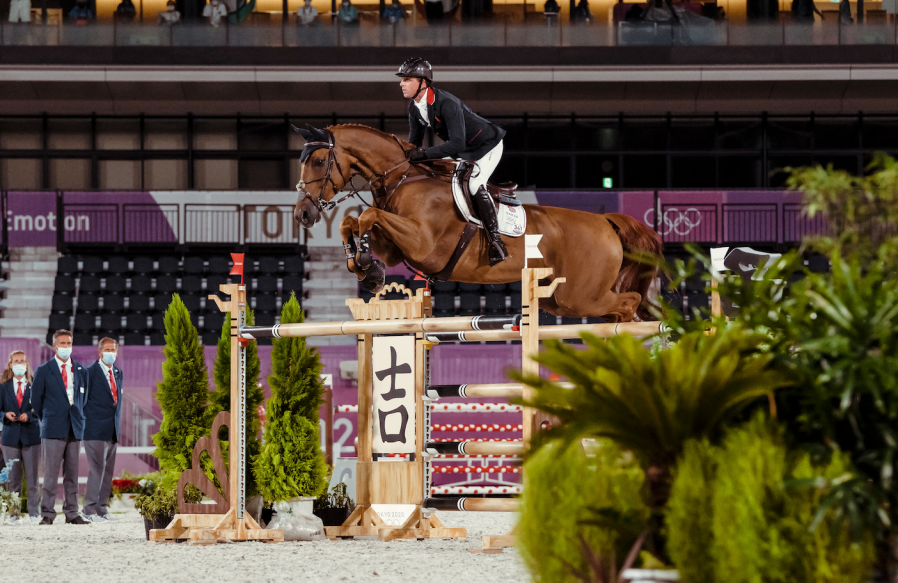
Great Britain’s Ben Maher and Explosion W are pictured at the Tokyo Olympics; they won individual gold
Jumping is an equestrian discipline in which horse and rider combinations jump colourful fences inside an arena, with penalties for knock-downs, refusals, horse or rider falls, and for going over the time allowed.
There are different levels of jumping (also commonly called showjumping) as both a national and international sport, and the maximum height and width of fences varies according to the class. Generally, the higher the level, the bigger the fences and more technical the course.
There is a variety of showjumping competitions to choose from, including speed events, and many will conclude with a jump-off. This is where the horse and riders jump a shorter class against the clock and the fastest clear wins.
Those who jump a clear round in the first phase will qualify for the jump-off. Sometimes those on four faults will go through too. The jump-off can be compared to a penalty shoot-out in football. The result is just as unpredictable and equally as exciting!
Olympic jumping
Jumping team qualifier
Team scores are decided by adding the penalties and time incurred by all three team members during their individual jumping rounds.
Horses and riders who do not start, withdraw, are eliminated or retire from the competition will not be given a score, and their team will be placed according to the combined scores of the remaining two team members.
Teams with three members will be placed ahead of teams of two.
The top 10 teams at the end of today (including any tied for 10th place) qualify for the Team Final, which is when they jump for medals.
Jumping team final
This second round is against the clock over one course of showjumps.
In the event of teams finishing on equal penalties, there will then be a jump off for first place.
Starting order for the team final is in reverse order of merit following the team qualifier.
Disqualification of a team member will result in disqualification for that team.
Jumping individual qualifier
This qualifier round is against the clock and there is no jump off. Riders are placed according to their penalties and in case of a tie they are separated by the time of their round. If still tied, they will be placed equal.
Jumping individual final
The final is one jumping round against the clock, with a jump off for first place if there is a tie on penalties.
All athletes start on a zero score and the starting order is in reverse order of merit, making for a tense and exciting finale.
What is eventing?
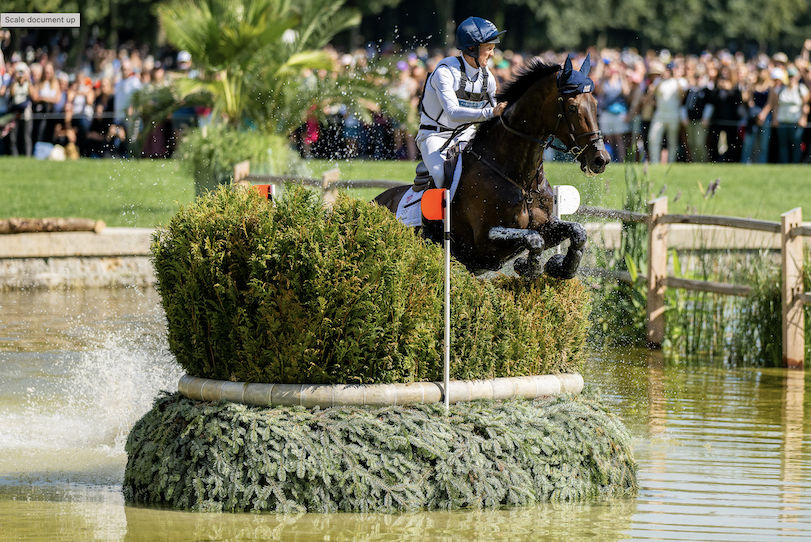
Team gold medal winners Tom McEwen and JL Dublin compete in the cross-country at the Paris Olympics for Britain
The equestrian sport of eventing has been part of the Olympics since 1912. It was once known as ‘The Military’, because it was a test for cavalrymen and their horses.
Eventing is the most comprehensive test of horse and rider. It combines the separate disciplines of dressage, cross-country and jumping.
There are teams of three and each of these horses and riders will complete a dressage test on day one, followed by a cross-country round on day two, before the final jumping rounds on day three.
Results from each phase for all three riders is added together to give a final score. It is the lowest score that wins, both for the team and individual medals.
At national level, where eventing (also called horse trials) take place on one day, horses do their showjumping round after the dressage, before a cross-country round. This is commonly called a one-day event.
Olympic eventing
The team and individual eventing competitions run concurrently over three consecutive days at the Olympics.
There are two horse inspections: one before the dressage and one after the cross-country, usually on the morning of the final jumping phase. Horses are inspected by the ground injury and have to be passed by them in order to continue in the competition.
A drawn starting order is used for the dressage and cross-country tests. For the final jumping rounds, horses and riders go in reverse order of merit.
Dressage
In the dressage phase, horses and riders complete a specified test in which they must perform certain movements, each one being marked out of 10. At the end, the marks will be added together and this is converted into a penalty score. The lowest penalty score is the best test.
Cross-country
For the cross-country, missing a fence (which is called a run out) or a stop (refusal) at a fence incurs 20 penalties. A horse and/or rider fall incurs 200 penalties and means elimination — they cannot complete their round.
An optimum time is set and for every second taken over this time a 0.4 penalty is given.
Jumping
There are two jumping rounds on the final day. The first round is to decide the team medals. The top 25 after this round then go forward to the second jumping round, where the individual medals are decided.
In jumping, a fence down incurs four penalties and 0.4 of a penalty is given for every second over the time allowed.
Horses can be substituted for the team competition, and a horse/rider combination may be substituted by a reserve combination for medical/veterinarian reasons in any of the three tests after the start of the competition.
Substitution will incur a penalty for the team of 20 points. One substitution per team is permitted.
What is dressage?
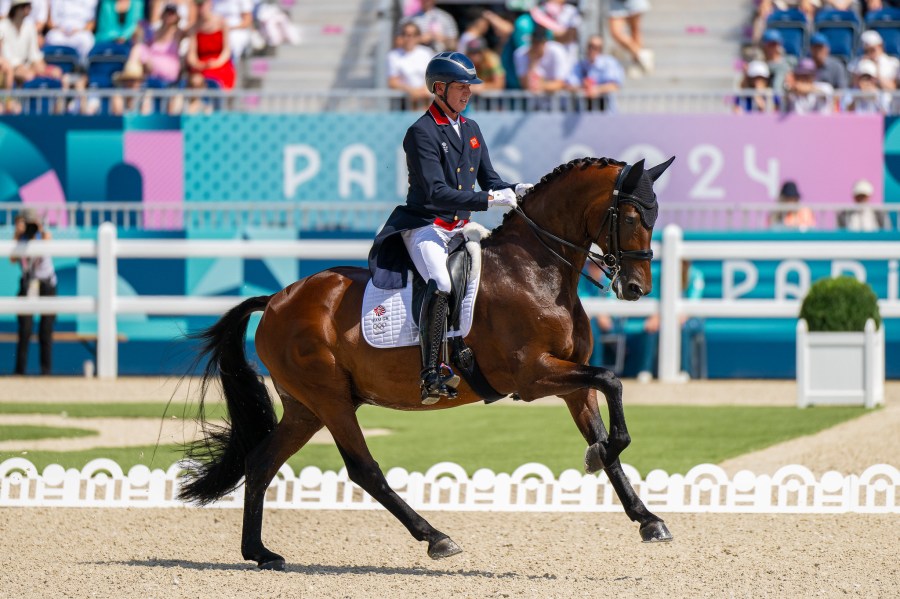
Carl Hester and Fame are pictured competing in the dressage events at the Paris Olympics
Dressage is about training the horse to a high level, highlighting its athleticism and the beauty of its movement and the harmony between horse and rider.
There are no jumps involved. Horse and rider will follow a specified test and are marked out of 10 for each movement.
Dressage tests are ridden inside an arena marked out by white boards and letters. At the Olympics, the arena is 20m wide by 60m long. At the lower levels, the arena is the same width but only 40 metres long and there are fewer letters.
Olympic dressage
The Grand Prix takes place first at the Olympics. This is a qualifier for both the team (Grand Prix Special) and individual competition (Grand Prix Freestyle).
The qualification ranking for the team competition will be decided by the combined results of all three team members in the Grand Prix.
Grand Prix
In the Grand Prix, athletes compete in six groups, with three groups competing on each day.
The composition of the groups is based on the FEI World Ranking list position of the horse on the date of definite entries.
Special
The top 10 teams in the Grand Prix (including any team tied for 10th place) will qualify for the Special, which is the team medal decider.
Freestyle
The top 18 in the Grand Prix will go through to the Freestyle. It is the top two combinations from each of the six Grand Prix groups, plus the combinations with the six next highest scores, who qualify.
The Freestyle is the final for the individual medals. Horses and riders perform their own test plan to music. There are certain movements that they have to include.
What is modern pentathlon?
Modern pentathlon isn’t strictly an equestrian sport at the Olympics, but it does include horses.
The five disciplines are:
- Fencing
- Swimming
- Equestrian jumping
- Running (3000 metres) and shooting combined
However, equestrian jumping is included in the Paris 2024 Olympics for the final time. It will be replaced by obstacle jumping at the 2028 Games in Los Angeles. This is due to serious concerns about horse welfare at the Tokyo Olympics.
Modern Pentathlon runs over three days for each gender. Points from each of the five events are added together to give final placings.
In the equestrian jumping, horses are drawn at random for athletes to ride. They then have 20 minutes to warm up and get to know the horse, before completing a course of 12 fences. The fewest mistakes in the fastest time scores the highest.
Main image (top): eventing athletes Laura Collett and London 52 compete in the final jumping phase at the Paris Olympics, where they won team gold and individual bronze for Team GB. All images: © FEI/Benjamin Clark

